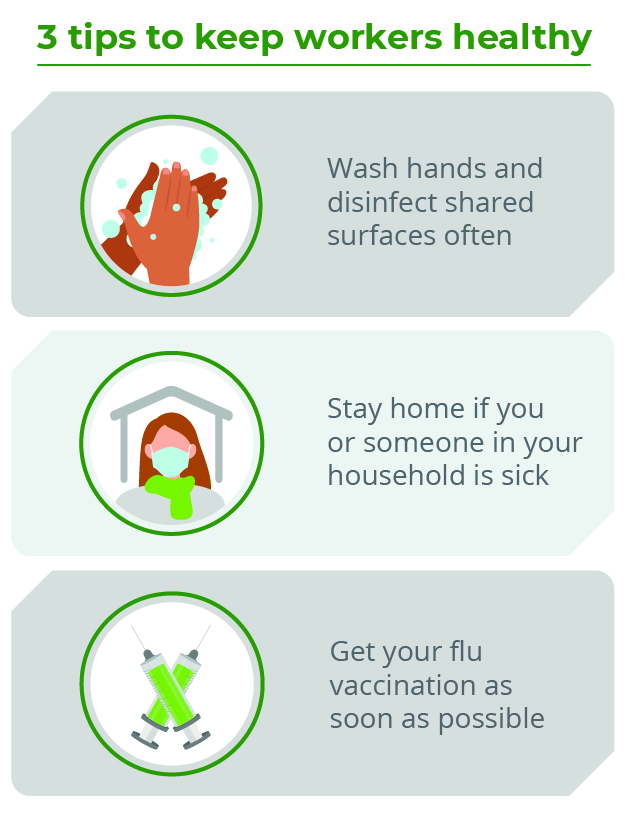
Business owners have a unique opportunity to help with flu prevention in the workplace and surrounding community. Flu precautions that emphasize workplace hygiene can also help reduce the spread of coronavirus and the common cold.
Learn how you can encourage your employees and clients to make flu prevention a top priority.
How to prevent the flu at work
The Centers for Disease Control and Prevention (CDC) says that getting your yearly flu vaccination is “the single best way to reduce the risk of seasonal flu and its potential serious complications.” However, there are many other important steps the CDC says you can take to keep yourself and your peers safe, including:
- Wash your hands often or use an alcohol-based hand sanitizer
- Avoid touching your face
- Clean and disinfect frequently touched surfaces
- Cover your nose and mouth to cough or sneeze
- Avoid close contact with others if you or they are sick
- Stay home when you are sick
Pay close attention to the areas with high foot traffic in your workplace or areas where people touch and can spread contamination easily. Disinfecting these areas often is a great flu prevention practice. Additionally, avoid handshakes and other physical contact to keep germ spreading to a minimum.
When possible, reduce in-person meetings and limit unnecessary visitors in the building. Turn to virtual meetings and apps like Zoom or Microsoft Teams to stay connected. If it’s necessary to stay in the office, provide employees and visitors with supplies like hand sanitizing stations, tissues, and disinfectant sprays or wipes.
Managing your stress, eating plenty of fruits and vegetables, staying hydrated and getting enough sleep each night are a few more flu precautions you can take.
By promoting flu vaccinations and sharing helpful tips to keep the workplace clean, you can help reduce the flu at work.

Other steps for preventing illness in the workplace
In addition to good workplace hygiene, try these flu precautions that can also help minimize the spread of coronavirus and other illnesses like the common cold:
- Practice social distancing—keep at least six feet between yourself and others to reduce the spread of airborne diseases
- Wear a face mask to prevent spreading the flu—this is another way to minimize the spread of germs through sneezing, coughing or spreading contagious droplets
- Stay home when you are exposed to a sick friend or family member—even if you feel fine, your exposure to someone with a cold, coronavirus or the flu can increase your chances of spreading illness if you come to work
The COVID-19 vaccine is another way to keep your peers safe at work. The CDC says “vaccines against COVID-19 are safe and effective. Vaccines teach our immune system to fight the virus that causes COVID-19.”
Lastly, make sure all your employees understand your sick leave policy in the event they do experience flu symptoms and need to stay home to recover.

Learn about our
Business Insurance
Flu safety and hybrid or remote work environments
One of the most effective forms of flu safety is to create a hybrid or virtual work environment where employees work remotely, typically from home. When employees have more opportunities to work from home, their exposure to potential illness drops significantly. For example, by spending less time at gas stations, convenience stores, restaurants and other establishments employees visit during a workday, they minimize their likelihood of contracting an illness. This reduction in potential exposure also lowers the risk of a sick employee spreading disease to other employees or customers.
To keep your business staffed and running smoothly, consider a remote or hybrid work environment to prevent the spread of COVID-19, influenza and other airborne illnesses. Continue to promote flu precautions and preventative measures to remind employees to keep their virtual work environments germ free.
3 employer benefits for work from home policies
In addition to health and safety, there are several ways work from home or remote work environments can be beneficial to employers:
1. Greater employee satisfaction
With more freedom to decide when, where and how they work, employees are more inclined to be happy at their job. There are also plenty of money saving opportunities. Employees who work from home can cut back on costs associated with car maintenance, gasoline, eating out, doggy daycare and more. Employee satisfaction through savings and comforts of being home can boost their productivity.
2. Higher staff retention
Employees take their health and safety into consideration for the jobs they seek out. Working from home allows employees to reduce their exposure to illness. When you provide a hybrid or remote work option, you can help keep your talent and reduce hiring and training needs.
3. Reduced workers compensation claims and other costs
By reducing the amount of time on-site, your risk for workers compensation can decrease. Less time spent at your business may also cut costs for utilities, cleaning services and other building maintenance.
Talk to Grange risk control experts about flu precautions
When you choose Grange for business insurance, you can depend on our risk control experts to help you develop a flu prevention plan or Injury and Illness Prevention Plan that works for your business needs. Whether you need assistance with flu safety measures around the office or you want to share information with employees and customers about flu symptoms and prevention, we can help. Talk to an independent Grange agent today to learn more.
This article is for informational and suggestion purposes only. Implementing these suggestions does not guarantee coverage. If any policy coverage descriptions in this article conflict with the language in the policy, the language in the policy applies. For full details on Grange’s business insurance coverages and discounts, contact your local independent agent.
References
CDC flu
CDC coronavirus
CDC flu prevention
Envoy.com
Gartner.com
University of Oxford